Report on Leadership and Operations Management at Procter & Gamble
VerifiedAdded on 2020/10/22
|17
|5457
|84
Report
AI Summary
This report provides a detailed analysis of leadership and operations management within Procter & Gamble. It begins with an introduction to operations management and the roles of leaders and managers, specifically within the context of P&G's organizational structure. The report then delves into the roles and characteristics of leaders and managers, comparing and contrasting them, along with the analysis of their functions. It explores various leadership theories, including transformational and transactional leadership, and examines how these theories apply in different situations within P&G, such as marketing strategies and team-building. The report also discusses key approaches to operations management and their significance in achieving business objectives, highlighting the impact of the business environment on operational decision-making. The report uses various models and theories, such as situational leadership, contingency leadership, and system leadership to provide a comprehensive overview of leadership and operational practices. The report concludes by evaluating the application of operations management and factors that impact the wider business environment.
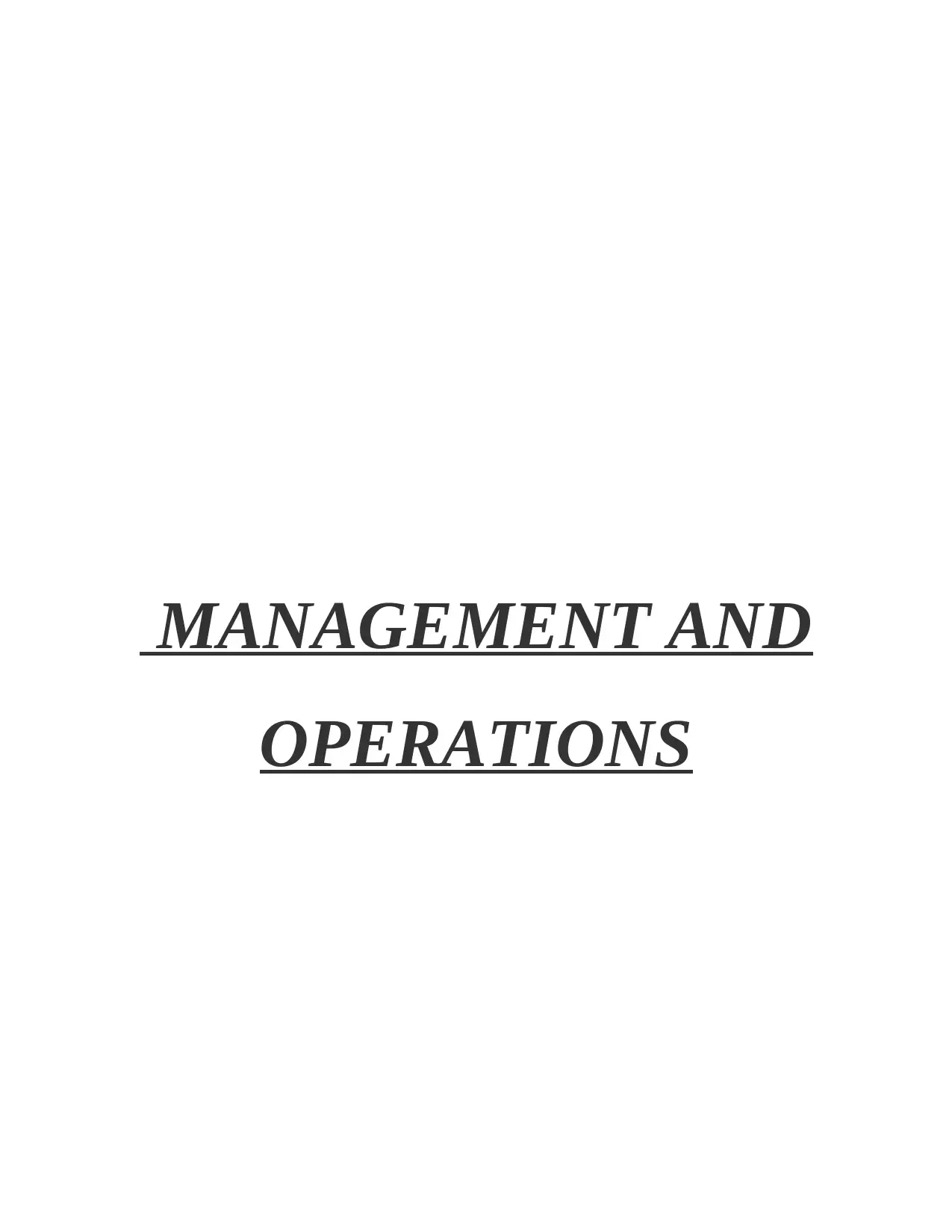
MANAGEMENT AND
OPERATIONS
OPERATIONS
Paraphrase This Document
Need a fresh take? Get an instant paraphrase of this document with our AI Paraphraser
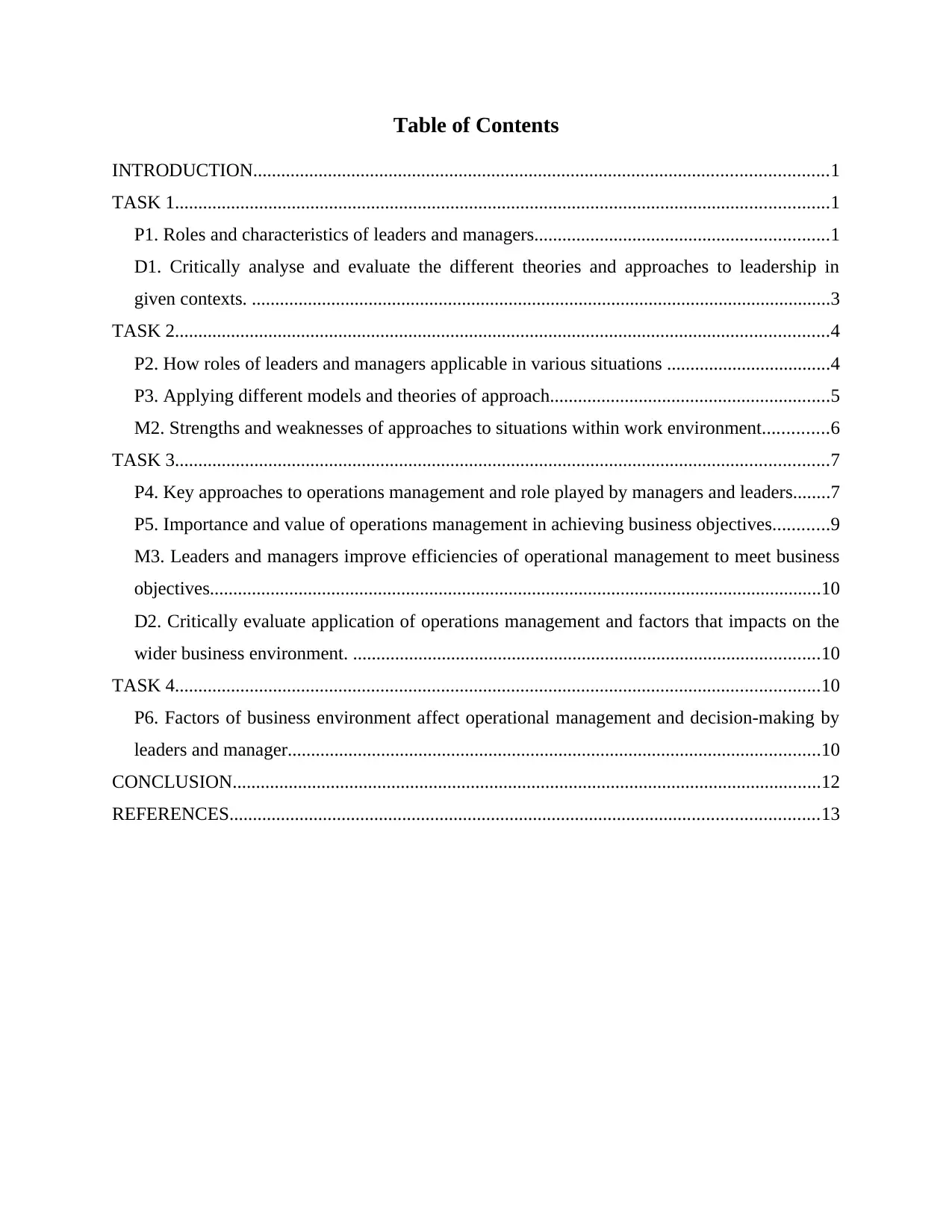
Table of Contents
INTRODUCTION...........................................................................................................................1
TASK 1............................................................................................................................................1
P1. Roles and characteristics of leaders and managers...............................................................1
D1. Critically analyse and evaluate the different theories and approaches to leadership in
given contexts. ............................................................................................................................3
TASK 2............................................................................................................................................4
P2. How roles of leaders and managers applicable in various situations ...................................4
P3. Applying different models and theories of approach............................................................5
M2. Strengths and weaknesses of approaches to situations within work environment..............6
TASK 3............................................................................................................................................7
P4. Key approaches to operations management and role played by managers and leaders........7
P5. Importance and value of operations management in achieving business objectives............9
M3. Leaders and managers improve efficiencies of operational management to meet business
objectives...................................................................................................................................10
D2. Critically evaluate application of operations management and factors that impacts on the
wider business environment. ....................................................................................................10
TASK 4..........................................................................................................................................10
P6. Factors of business environment affect operational management and decision-making by
leaders and manager..................................................................................................................10
CONCLUSION..............................................................................................................................12
REFERENCES..............................................................................................................................13
INTRODUCTION...........................................................................................................................1
TASK 1............................................................................................................................................1
P1. Roles and characteristics of leaders and managers...............................................................1
D1. Critically analyse and evaluate the different theories and approaches to leadership in
given contexts. ............................................................................................................................3
TASK 2............................................................................................................................................4
P2. How roles of leaders and managers applicable in various situations ...................................4
P3. Applying different models and theories of approach............................................................5
M2. Strengths and weaknesses of approaches to situations within work environment..............6
TASK 3............................................................................................................................................7
P4. Key approaches to operations management and role played by managers and leaders........7
P5. Importance and value of operations management in achieving business objectives............9
M3. Leaders and managers improve efficiencies of operational management to meet business
objectives...................................................................................................................................10
D2. Critically evaluate application of operations management and factors that impacts on the
wider business environment. ....................................................................................................10
TASK 4..........................................................................................................................................10
P6. Factors of business environment affect operational management and decision-making by
leaders and manager..................................................................................................................10
CONCLUSION..............................................................................................................................12
REFERENCES..............................................................................................................................13

⊘ This is a preview!⊘
Do you want full access?
Subscribe today to unlock all pages.

Trusted by 1+ million students worldwide
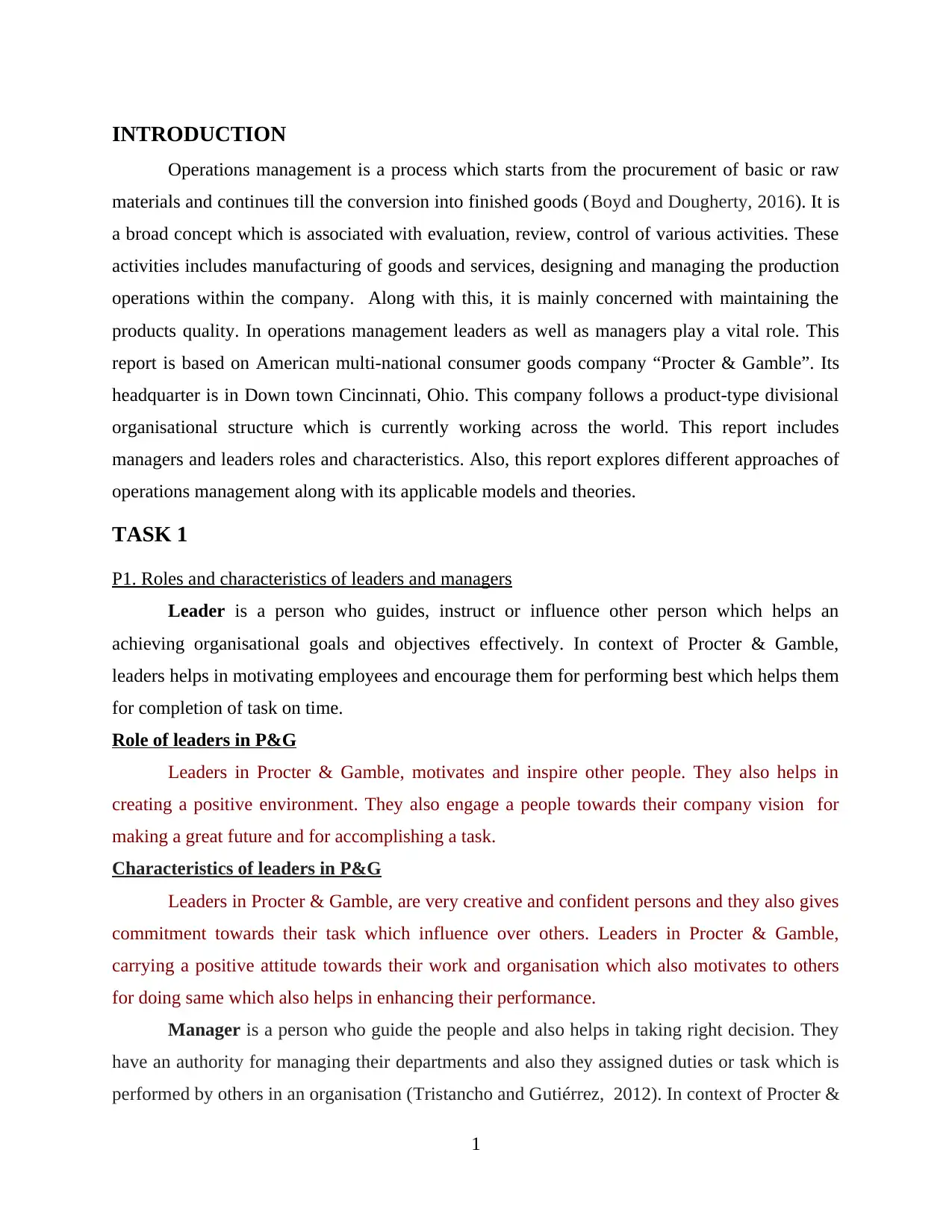
INTRODUCTION
Operations management is a process which starts from the procurement of basic or raw
materials and continues till the conversion into finished goods (Boyd and Dougherty, 2016). It is
a broad concept which is associated with evaluation, review, control of various activities. These
activities includes manufacturing of goods and services, designing and managing the production
operations within the company. Along with this, it is mainly concerned with maintaining the
products quality. In operations management leaders as well as managers play a vital role. This
report is based on American multi-national consumer goods company “Procter & Gamble”. Its
headquarter is in Down town Cincinnati, Ohio. This company follows a product-type divisional
organisational structure which is currently working across the world. This report includes
managers and leaders roles and characteristics. Also, this report explores different approaches of
operations management along with its applicable models and theories.
TASK 1
P1. Roles and characteristics of leaders and managers
Leader is a person who guides, instruct or influence other person which helps an
achieving organisational goals and objectives effectively. In context of Procter & Gamble,
leaders helps in motivating employees and encourage them for performing best which helps them
for completion of task on time.
Role of leaders in P&G
Leaders in Procter & Gamble, motivates and inspire other people. They also helps in
creating a positive environment. They also engage a people towards their company vision for
making a great future and for accomplishing a task.
Characteristics of leaders in P&G
Leaders in Procter & Gamble, are very creative and confident persons and they also gives
commitment towards their task which influence over others. Leaders in Procter & Gamble,
carrying a positive attitude towards their work and organisation which also motivates to others
for doing same which also helps in enhancing their performance.
Manager is a person who guide the people and also helps in taking right decision. They
have an authority for managing their departments and also they assigned duties or task which is
performed by others in an organisation (Tristancho and Gutiérrez, 2012). In context of Procter &
1
Operations management is a process which starts from the procurement of basic or raw
materials and continues till the conversion into finished goods (Boyd and Dougherty, 2016). It is
a broad concept which is associated with evaluation, review, control of various activities. These
activities includes manufacturing of goods and services, designing and managing the production
operations within the company. Along with this, it is mainly concerned with maintaining the
products quality. In operations management leaders as well as managers play a vital role. This
report is based on American multi-national consumer goods company “Procter & Gamble”. Its
headquarter is in Down town Cincinnati, Ohio. This company follows a product-type divisional
organisational structure which is currently working across the world. This report includes
managers and leaders roles and characteristics. Also, this report explores different approaches of
operations management along with its applicable models and theories.
TASK 1
P1. Roles and characteristics of leaders and managers
Leader is a person who guides, instruct or influence other person which helps an
achieving organisational goals and objectives effectively. In context of Procter & Gamble,
leaders helps in motivating employees and encourage them for performing best which helps them
for completion of task on time.
Role of leaders in P&G
Leaders in Procter & Gamble, motivates and inspire other people. They also helps in
creating a positive environment. They also engage a people towards their company vision for
making a great future and for accomplishing a task.
Characteristics of leaders in P&G
Leaders in Procter & Gamble, are very creative and confident persons and they also gives
commitment towards their task which influence over others. Leaders in Procter & Gamble,
carrying a positive attitude towards their work and organisation which also motivates to others
for doing same which also helps in enhancing their performance.
Manager is a person who guide the people and also helps in taking right decision. They
have an authority for managing their departments and also they assigned duties or task which is
performed by others in an organisation (Tristancho and Gutiérrez, 2012). In context of Procter &
1
Paraphrase This Document
Need a fresh take? Get an instant paraphrase of this document with our AI Paraphraser

Gambler, manager is a person who controls business activities for achieving organisational goal
and objectives.
Role of managers in Procter & Gambler
Managers in Procter & Gambler, is managing and controlling their department for
performing their task effectively and efficiently. Managers in Procter & Gambler, they follow an
open-door policy, which means they helps their subordinates for sharing their views or ideas
which also helps in making right decisions.
Characteristics of managers in Procter & Gambler
Managers in Procter & Gambler, helps in effective communication between superior and
subordinates and they also develop confidence between employees which motivates them for
doing their work accordingly. Managers in Procter & Gambler, have complete and proper
knowledge. They have various degees including bachelors degree of business or masters degree
in leadership or time management.
Similarities between Managers and Leaders of Procter & Gambler
Both managers and leaders play important role in organisation and their main
objective is to enhance profitability.
They both motivates other employees for performing their task effectively which
helps in decision-making.
Differences between management and leadership of Procter & Gambler
Basis of comparison Managers Leaders
Authority and power Managers have authority for
assigning task and duties, and
also help in decision-making.
Leaders have power, to put
influence over others and also
helps them to complete their
task on time.
Behavioural characteristics Managers in Procter &
Gambler, are very creative and
innovative. It helps in
attracting customers and
capturing market share.
Leaders in Procter & Gambler,
are motivates other and also
carrying a positive attitude
towards their work.
Subordinates Employees are their Group of individuals are their
2
and objectives.
Role of managers in Procter & Gambler
Managers in Procter & Gambler, is managing and controlling their department for
performing their task effectively and efficiently. Managers in Procter & Gambler, they follow an
open-door policy, which means they helps their subordinates for sharing their views or ideas
which also helps in making right decisions.
Characteristics of managers in Procter & Gambler
Managers in Procter & Gambler, helps in effective communication between superior and
subordinates and they also develop confidence between employees which motivates them for
doing their work accordingly. Managers in Procter & Gambler, have complete and proper
knowledge. They have various degees including bachelors degree of business or masters degree
in leadership or time management.
Similarities between Managers and Leaders of Procter & Gambler
Both managers and leaders play important role in organisation and their main
objective is to enhance profitability.
They both motivates other employees for performing their task effectively which
helps in decision-making.
Differences between management and leadership of Procter & Gambler
Basis of comparison Managers Leaders
Authority and power Managers have authority for
assigning task and duties, and
also help in decision-making.
Leaders have power, to put
influence over others and also
helps them to complete their
task on time.
Behavioural characteristics Managers in Procter &
Gambler, are very creative and
innovative. It helps in
attracting customers and
capturing market share.
Leaders in Procter & Gambler,
are motivates other and also
carrying a positive attitude
towards their work.
Subordinates Employees are their Group of individuals are their
2

subordinates. followers.
3
3
⊘ This is a preview!⊘
Do you want full access?
Subscribe today to unlock all pages.

Trusted by 1+ million students worldwide
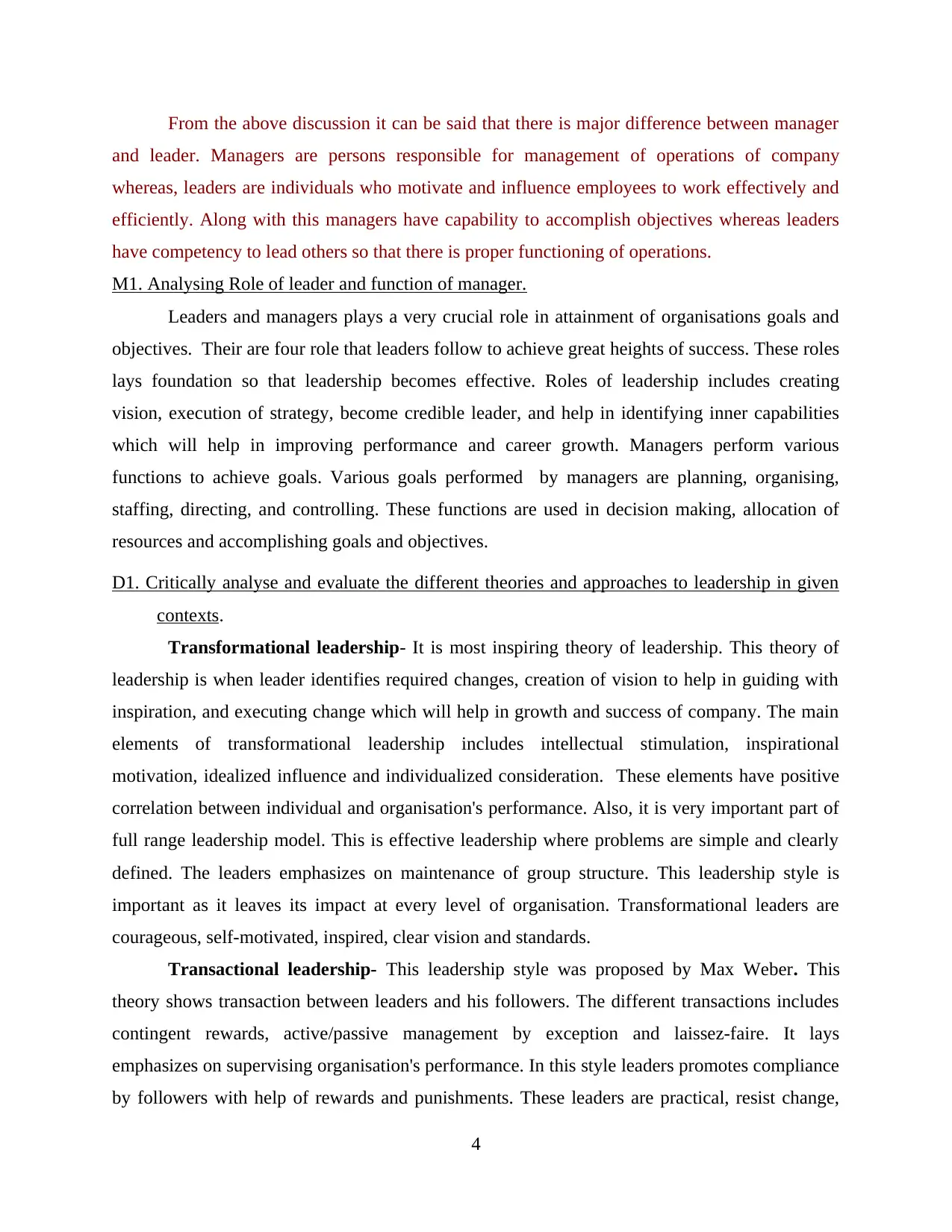
From the above discussion it can be said that there is major difference between manager
and leader. Managers are persons responsible for management of operations of company
whereas, leaders are individuals who motivate and influence employees to work effectively and
efficiently. Along with this managers have capability to accomplish objectives whereas leaders
have competency to lead others so that there is proper functioning of operations.
M1. Analysing Role of leader and function of manager.
Leaders and managers plays a very crucial role in attainment of organisations goals and
objectives. Their are four role that leaders follow to achieve great heights of success. These roles
lays foundation so that leadership becomes effective. Roles of leadership includes creating
vision, execution of strategy, become credible leader, and help in identifying inner capabilities
which will help in improving performance and career growth. Managers perform various
functions to achieve goals. Various goals performed by managers are planning, organising,
staffing, directing, and controlling. These functions are used in decision making, allocation of
resources and accomplishing goals and objectives.
D1. Critically analyse and evaluate the different theories and approaches to leadership in given
contexts.
Transformational leadership- It is most inspiring theory of leadership. This theory of
leadership is when leader identifies required changes, creation of vision to help in guiding with
inspiration, and executing change which will help in growth and success of company. The main
elements of transformational leadership includes intellectual stimulation, inspirational
motivation, idealized influence and individualized consideration. These elements have positive
correlation between individual and organisation's performance. Also, it is very important part of
full range leadership model. This is effective leadership where problems are simple and clearly
defined. The leaders emphasizes on maintenance of group structure. This leadership style is
important as it leaves its impact at every level of organisation. Transformational leaders are
courageous, self-motivated, inspired, clear vision and standards.
Transactional leadership- This leadership style was proposed by Max Weber. This
theory shows transaction between leaders and his followers. The different transactions includes
contingent rewards, active/passive management by exception and laissez-faire. It lays
emphasizes on supervising organisation's performance. In this style leaders promotes compliance
by followers with help of rewards and punishments. These leaders are practical, resist change,
4
and leader. Managers are persons responsible for management of operations of company
whereas, leaders are individuals who motivate and influence employees to work effectively and
efficiently. Along with this managers have capability to accomplish objectives whereas leaders
have competency to lead others so that there is proper functioning of operations.
M1. Analysing Role of leader and function of manager.
Leaders and managers plays a very crucial role in attainment of organisations goals and
objectives. Their are four role that leaders follow to achieve great heights of success. These roles
lays foundation so that leadership becomes effective. Roles of leadership includes creating
vision, execution of strategy, become credible leader, and help in identifying inner capabilities
which will help in improving performance and career growth. Managers perform various
functions to achieve goals. Various goals performed by managers are planning, organising,
staffing, directing, and controlling. These functions are used in decision making, allocation of
resources and accomplishing goals and objectives.
D1. Critically analyse and evaluate the different theories and approaches to leadership in given
contexts.
Transformational leadership- It is most inspiring theory of leadership. This theory of
leadership is when leader identifies required changes, creation of vision to help in guiding with
inspiration, and executing change which will help in growth and success of company. The main
elements of transformational leadership includes intellectual stimulation, inspirational
motivation, idealized influence and individualized consideration. These elements have positive
correlation between individual and organisation's performance. Also, it is very important part of
full range leadership model. This is effective leadership where problems are simple and clearly
defined. The leaders emphasizes on maintenance of group structure. This leadership style is
important as it leaves its impact at every level of organisation. Transformational leaders are
courageous, self-motivated, inspired, clear vision and standards.
Transactional leadership- This leadership style was proposed by Max Weber. This
theory shows transaction between leaders and his followers. The different transactions includes
contingent rewards, active/passive management by exception and laissez-faire. It lays
emphasizes on supervising organisation's performance. In this style leaders promotes compliance
by followers with help of rewards and punishments. These leaders are practical, resist change,
4
Paraphrase This Document
Need a fresh take? Get an instant paraphrase of this document with our AI Paraphraser

motivated externally, and discourage independent thinking. This is mostly used by managers as it
mainly focuses on controlling, short-term planning and organizing. As clear guidelines for
performance are established which helps in increasing productivity and efficiency in
organisation. Leaders are not concerned with well-being of employees.
TASK 2
P2. How roles of leaders and managers applicable in various situations .
Procter & Gamble is American based multi-national consumer goods corporation. It deals
in various segments including beauty, grooming, baby care, family care, fabric & home care.
Also, it includes snacks, foods and beverages (Plesser, 2014). To remain competitive in business
environment it is very important to formulate business strategies for Procter & Gamble.
Managers and leaders play a very crucial role for accomplishment of goals and objectives and
competitive advantage. Managers in Procter & Gamble conduct various activities including
planning for business, marketing strategies, assigning work to subordinates according to skills
possessed by them. It is compulsory for Procter & Gamble to keep updating their technologies
and strategies according to changing customer needs and preferences. So, that leaders impart
training in their teams and inspire and motivate employees to help in improving their skills and
attain goals and objectives. On the other aspect, manager of Procter & Gamble helps in
development of organisation. Managers and leaders of Procter & Gamble have to work in
coordination which help in overcoming complex situations effectively and efficiently. Critical
situations with regards to Procter & Gamble are discussed below:-
Marketing strategies:- The most complex task for Procter & Gamble is marketing
strategies and techniques. In this, managers of Procter & Gamble follow different types of
marketing strategies. Company adopts traditional marketing strategies including print and TV
advertising. Managers of Procter & Gamble directs its team members which helps in
competitive advantage and attainment of objectives and goals. On the other hand leaders of
Procter & Gamble helps in formulating strategies and emphasizes on customer satisfaction. Best
and effective marketing strategies will help Procter & Gamble in attracting and retaining new
customers and help in accomplishment of goals and objectives.
Team-building:-This is most critical task for an organisation as members belong to
different organisation culture. In this, managers of Procter & Gamble follows combination of
5
mainly focuses on controlling, short-term planning and organizing. As clear guidelines for
performance are established which helps in increasing productivity and efficiency in
organisation. Leaders are not concerned with well-being of employees.
TASK 2
P2. How roles of leaders and managers applicable in various situations .
Procter & Gamble is American based multi-national consumer goods corporation. It deals
in various segments including beauty, grooming, baby care, family care, fabric & home care.
Also, it includes snacks, foods and beverages (Plesser, 2014). To remain competitive in business
environment it is very important to formulate business strategies for Procter & Gamble.
Managers and leaders play a very crucial role for accomplishment of goals and objectives and
competitive advantage. Managers in Procter & Gamble conduct various activities including
planning for business, marketing strategies, assigning work to subordinates according to skills
possessed by them. It is compulsory for Procter & Gamble to keep updating their technologies
and strategies according to changing customer needs and preferences. So, that leaders impart
training in their teams and inspire and motivate employees to help in improving their skills and
attain goals and objectives. On the other aspect, manager of Procter & Gamble helps in
development of organisation. Managers and leaders of Procter & Gamble have to work in
coordination which help in overcoming complex situations effectively and efficiently. Critical
situations with regards to Procter & Gamble are discussed below:-
Marketing strategies:- The most complex task for Procter & Gamble is marketing
strategies and techniques. In this, managers of Procter & Gamble follow different types of
marketing strategies. Company adopts traditional marketing strategies including print and TV
advertising. Managers of Procter & Gamble directs its team members which helps in
competitive advantage and attainment of objectives and goals. On the other hand leaders of
Procter & Gamble helps in formulating strategies and emphasizes on customer satisfaction. Best
and effective marketing strategies will help Procter & Gamble in attracting and retaining new
customers and help in accomplishment of goals and objectives.
Team-building:-This is most critical task for an organisation as members belong to
different organisation culture. In this, managers of Procter & Gamble follows combination of
5
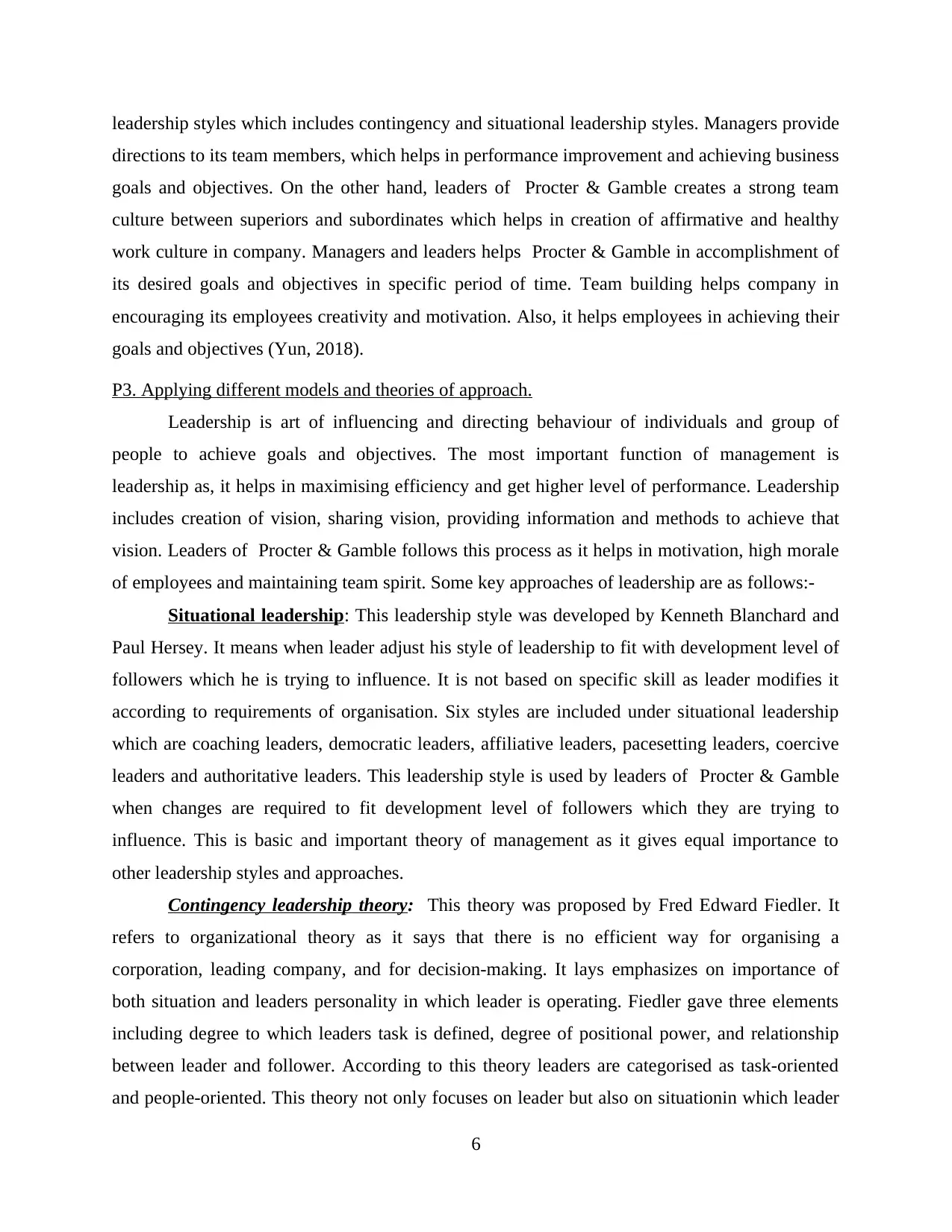
leadership styles which includes contingency and situational leadership styles. Managers provide
directions to its team members, which helps in performance improvement and achieving business
goals and objectives. On the other hand, leaders of Procter & Gamble creates a strong team
culture between superiors and subordinates which helps in creation of affirmative and healthy
work culture in company. Managers and leaders helps Procter & Gamble in accomplishment of
its desired goals and objectives in specific period of time. Team building helps company in
encouraging its employees creativity and motivation. Also, it helps employees in achieving their
goals and objectives (Yun, 2018).
P3. Applying different models and theories of approach.
Leadership is art of influencing and directing behaviour of individuals and group of
people to achieve goals and objectives. The most important function of management is
leadership as, it helps in maximising efficiency and get higher level of performance. Leadership
includes creation of vision, sharing vision, providing information and methods to achieve that
vision. Leaders of Procter & Gamble follows this process as it helps in motivation, high morale
of employees and maintaining team spirit. Some key approaches of leadership are as follows:-
Situational leadership: This leadership style was developed by Kenneth Blanchard and
Paul Hersey. It means when leader adjust his style of leadership to fit with development level of
followers which he is trying to influence. It is not based on specific skill as leader modifies it
according to requirements of organisation. Six styles are included under situational leadership
which are coaching leaders, democratic leaders, affiliative leaders, pacesetting leaders, coercive
leaders and authoritative leaders. This leadership style is used by leaders of Procter & Gamble
when changes are required to fit development level of followers which they are trying to
influence. This is basic and important theory of management as it gives equal importance to
other leadership styles and approaches.
Contingency leadership theory: This theory was proposed by Fred Edward Fiedler. It
refers to organizational theory as it says that there is no efficient way for organising a
corporation, leading company, and for decision-making. It lays emphasizes on importance of
both situation and leaders personality in which leader is operating. Fiedler gave three elements
including degree to which leaders task is defined, degree of positional power, and relationship
between leader and follower. According to this theory leaders are categorised as task-oriented
and people-oriented. This theory not only focuses on leader but also on situationin which leader
6
directions to its team members, which helps in performance improvement and achieving business
goals and objectives. On the other hand, leaders of Procter & Gamble creates a strong team
culture between superiors and subordinates which helps in creation of affirmative and healthy
work culture in company. Managers and leaders helps Procter & Gamble in accomplishment of
its desired goals and objectives in specific period of time. Team building helps company in
encouraging its employees creativity and motivation. Also, it helps employees in achieving their
goals and objectives (Yun, 2018).
P3. Applying different models and theories of approach.
Leadership is art of influencing and directing behaviour of individuals and group of
people to achieve goals and objectives. The most important function of management is
leadership as, it helps in maximising efficiency and get higher level of performance. Leadership
includes creation of vision, sharing vision, providing information and methods to achieve that
vision. Leaders of Procter & Gamble follows this process as it helps in motivation, high morale
of employees and maintaining team spirit. Some key approaches of leadership are as follows:-
Situational leadership: This leadership style was developed by Kenneth Blanchard and
Paul Hersey. It means when leader adjust his style of leadership to fit with development level of
followers which he is trying to influence. It is not based on specific skill as leader modifies it
according to requirements of organisation. Six styles are included under situational leadership
which are coaching leaders, democratic leaders, affiliative leaders, pacesetting leaders, coercive
leaders and authoritative leaders. This leadership style is used by leaders of Procter & Gamble
when changes are required to fit development level of followers which they are trying to
influence. This is basic and important theory of management as it gives equal importance to
other leadership styles and approaches.
Contingency leadership theory: This theory was proposed by Fred Edward Fiedler. It
refers to organizational theory as it says that there is no efficient way for organising a
corporation, leading company, and for decision-making. It lays emphasizes on importance of
both situation and leaders personality in which leader is operating. Fiedler gave three elements
including degree to which leaders task is defined, degree of positional power, and relationship
between leader and follower. According to this theory leaders are categorised as task-oriented
and people-oriented. This theory not only focuses on leader but also on situationin which leader
6
⊘ This is a preview!⊘
Do you want full access?
Subscribe today to unlock all pages.

Trusted by 1+ million students worldwide
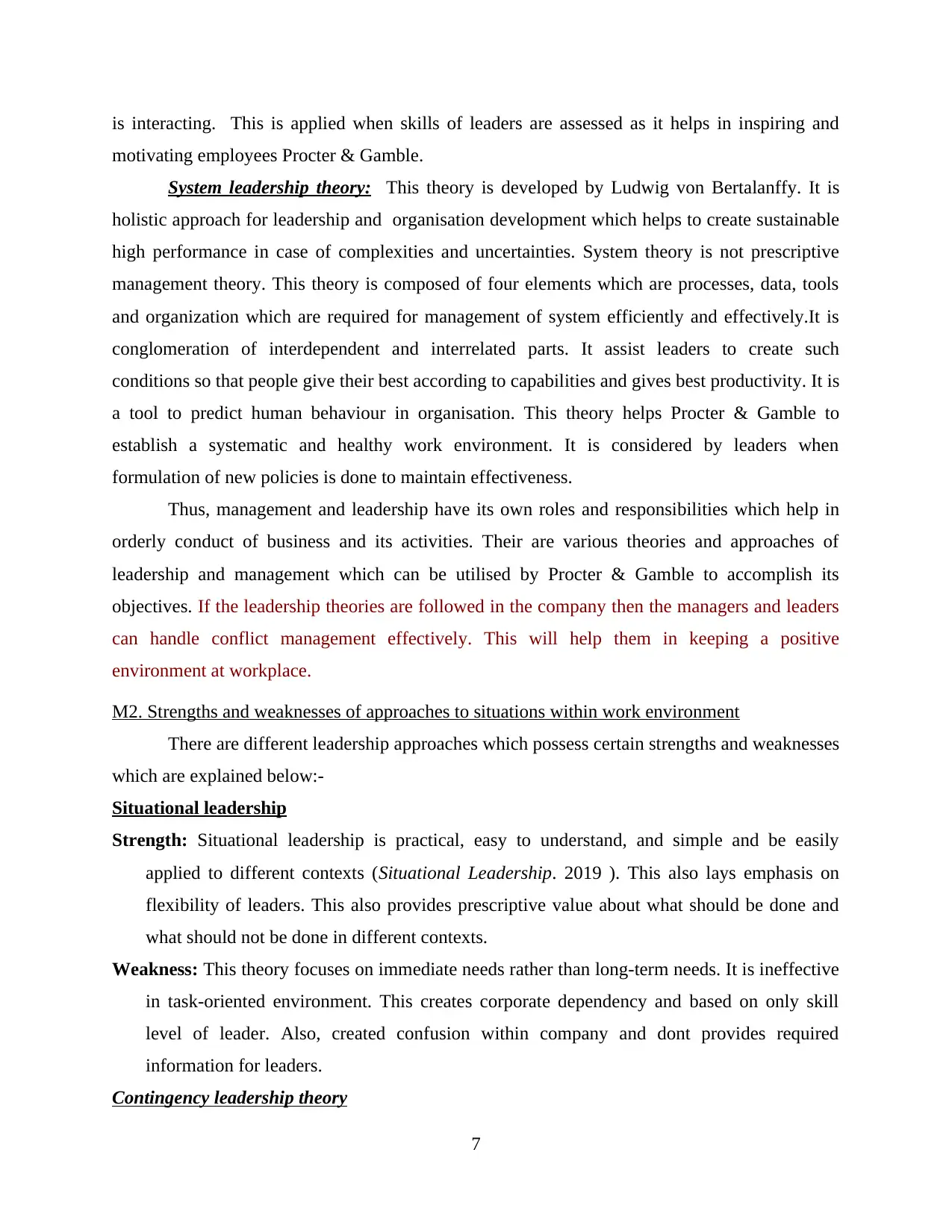
is interacting. This is applied when skills of leaders are assessed as it helps in inspiring and
motivating employees Procter & Gamble.
System leadership theory: This theory is developed by Ludwig von Bertalanffy. It is
holistic approach for leadership and organisation development which helps to create sustainable
high performance in case of complexities and uncertainties. System theory is not prescriptive
management theory. This theory is composed of four elements which are processes, data, tools
and organization which are required for management of system efficiently and effectively.It is
conglomeration of interdependent and interrelated parts. It assist leaders to create such
conditions so that people give their best according to capabilities and gives best productivity. It is
a tool to predict human behaviour in organisation. This theory helps Procter & Gamble to
establish a systematic and healthy work environment. It is considered by leaders when
formulation of new policies is done to maintain effectiveness.
Thus, management and leadership have its own roles and responsibilities which help in
orderly conduct of business and its activities. Their are various theories and approaches of
leadership and management which can be utilised by Procter & Gamble to accomplish its
objectives. If the leadership theories are followed in the company then the managers and leaders
can handle conflict management effectively. This will help them in keeping a positive
environment at workplace.
M2. Strengths and weaknesses of approaches to situations within work environment
There are different leadership approaches which possess certain strengths and weaknesses
which are explained below:-
Situational leadership
Strength: Situational leadership is practical, easy to understand, and simple and be easily
applied to different contexts (Situational Leadership. 2019 ). This also lays emphasis on
flexibility of leaders. This also provides prescriptive value about what should be done and
what should not be done in different contexts.
Weakness: This theory focuses on immediate needs rather than long-term needs. It is ineffective
in task-oriented environment. This creates corporate dependency and based on only skill
level of leader. Also, created confusion within company and dont provides required
information for leaders.
Contingency leadership theory
7
motivating employees Procter & Gamble.
System leadership theory: This theory is developed by Ludwig von Bertalanffy. It is
holistic approach for leadership and organisation development which helps to create sustainable
high performance in case of complexities and uncertainties. System theory is not prescriptive
management theory. This theory is composed of four elements which are processes, data, tools
and organization which are required for management of system efficiently and effectively.It is
conglomeration of interdependent and interrelated parts. It assist leaders to create such
conditions so that people give their best according to capabilities and gives best productivity. It is
a tool to predict human behaviour in organisation. This theory helps Procter & Gamble to
establish a systematic and healthy work environment. It is considered by leaders when
formulation of new policies is done to maintain effectiveness.
Thus, management and leadership have its own roles and responsibilities which help in
orderly conduct of business and its activities. Their are various theories and approaches of
leadership and management which can be utilised by Procter & Gamble to accomplish its
objectives. If the leadership theories are followed in the company then the managers and leaders
can handle conflict management effectively. This will help them in keeping a positive
environment at workplace.
M2. Strengths and weaknesses of approaches to situations within work environment
There are different leadership approaches which possess certain strengths and weaknesses
which are explained below:-
Situational leadership
Strength: Situational leadership is practical, easy to understand, and simple and be easily
applied to different contexts (Situational Leadership. 2019 ). This also lays emphasis on
flexibility of leaders. This also provides prescriptive value about what should be done and
what should not be done in different contexts.
Weakness: This theory focuses on immediate needs rather than long-term needs. It is ineffective
in task-oriented environment. This creates corporate dependency and based on only skill
level of leader. Also, created confusion within company and dont provides required
information for leaders.
Contingency leadership theory
7
Paraphrase This Document
Need a fresh take? Get an instant paraphrase of this document with our AI Paraphraser
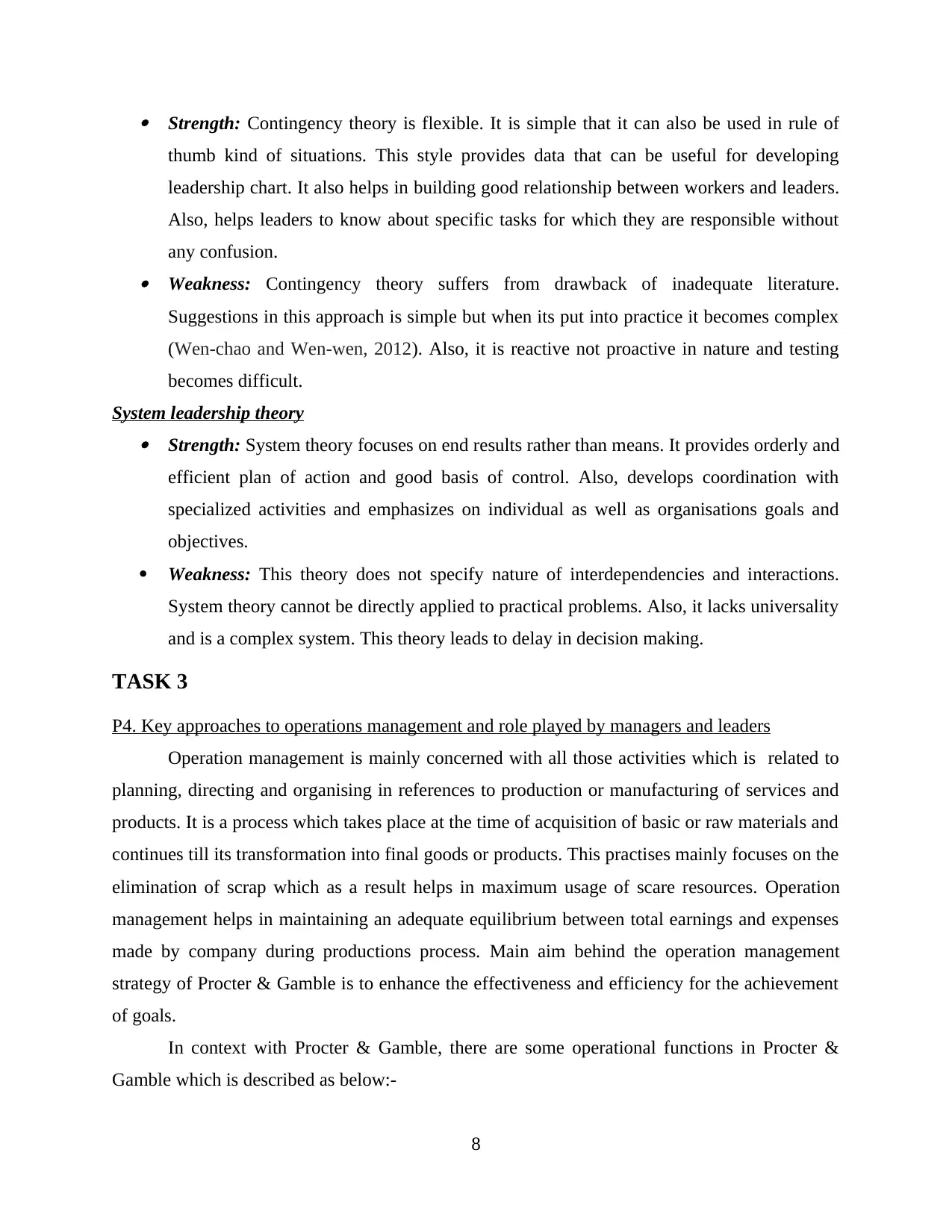
Strength: Contingency theory is flexible. It is simple that it can also be used in rule of
thumb kind of situations. This style provides data that can be useful for developing
leadership chart. It also helps in building good relationship between workers and leaders.
Also, helps leaders to know about specific tasks for which they are responsible without
any confusion. Weakness: Contingency theory suffers from drawback of inadequate literature.
Suggestions in this approach is simple but when its put into practice it becomes complex
(Wen-chao and Wen-wen, 2012). Also, it is reactive not proactive in nature and testing
becomes difficult.
System leadership theory Strength: System theory focuses on end results rather than means. It provides orderly and
efficient plan of action and good basis of control. Also, develops coordination with
specialized activities and emphasizes on individual as well as organisations goals and
objectives.
Weakness: This theory does not specify nature of interdependencies and interactions.
System theory cannot be directly applied to practical problems. Also, it lacks universality
and is a complex system. This theory leads to delay in decision making.
TASK 3
P4. Key approaches to operations management and role played by managers and leaders
Operation management is mainly concerned with all those activities which is related to
planning, directing and organising in references to production or manufacturing of services and
products. It is a process which takes place at the time of acquisition of basic or raw materials and
continues till its transformation into final goods or products. This practises mainly focuses on the
elimination of scrap which as a result helps in maximum usage of scare resources. Operation
management helps in maintaining an adequate equilibrium between total earnings and expenses
made by company during productions process. Main aim behind the operation management
strategy of Procter & Gamble is to enhance the effectiveness and efficiency for the achievement
of goals.
In context with Procter & Gamble, there are some operational functions in Procter &
Gamble which is described as below:-
8
thumb kind of situations. This style provides data that can be useful for developing
leadership chart. It also helps in building good relationship between workers and leaders.
Also, helps leaders to know about specific tasks for which they are responsible without
any confusion. Weakness: Contingency theory suffers from drawback of inadequate literature.
Suggestions in this approach is simple but when its put into practice it becomes complex
(Wen-chao and Wen-wen, 2012). Also, it is reactive not proactive in nature and testing
becomes difficult.
System leadership theory Strength: System theory focuses on end results rather than means. It provides orderly and
efficient plan of action and good basis of control. Also, develops coordination with
specialized activities and emphasizes on individual as well as organisations goals and
objectives.
Weakness: This theory does not specify nature of interdependencies and interactions.
System theory cannot be directly applied to practical problems. Also, it lacks universality
and is a complex system. This theory leads to delay in decision making.
TASK 3
P4. Key approaches to operations management and role played by managers and leaders
Operation management is mainly concerned with all those activities which is related to
planning, directing and organising in references to production or manufacturing of services and
products. It is a process which takes place at the time of acquisition of basic or raw materials and
continues till its transformation into final goods or products. This practises mainly focuses on the
elimination of scrap which as a result helps in maximum usage of scare resources. Operation
management helps in maintaining an adequate equilibrium between total earnings and expenses
made by company during productions process. Main aim behind the operation management
strategy of Procter & Gamble is to enhance the effectiveness and efficiency for the achievement
of goals.
In context with Procter & Gamble, there are some operational functions in Procter &
Gamble which is described as below:-
8
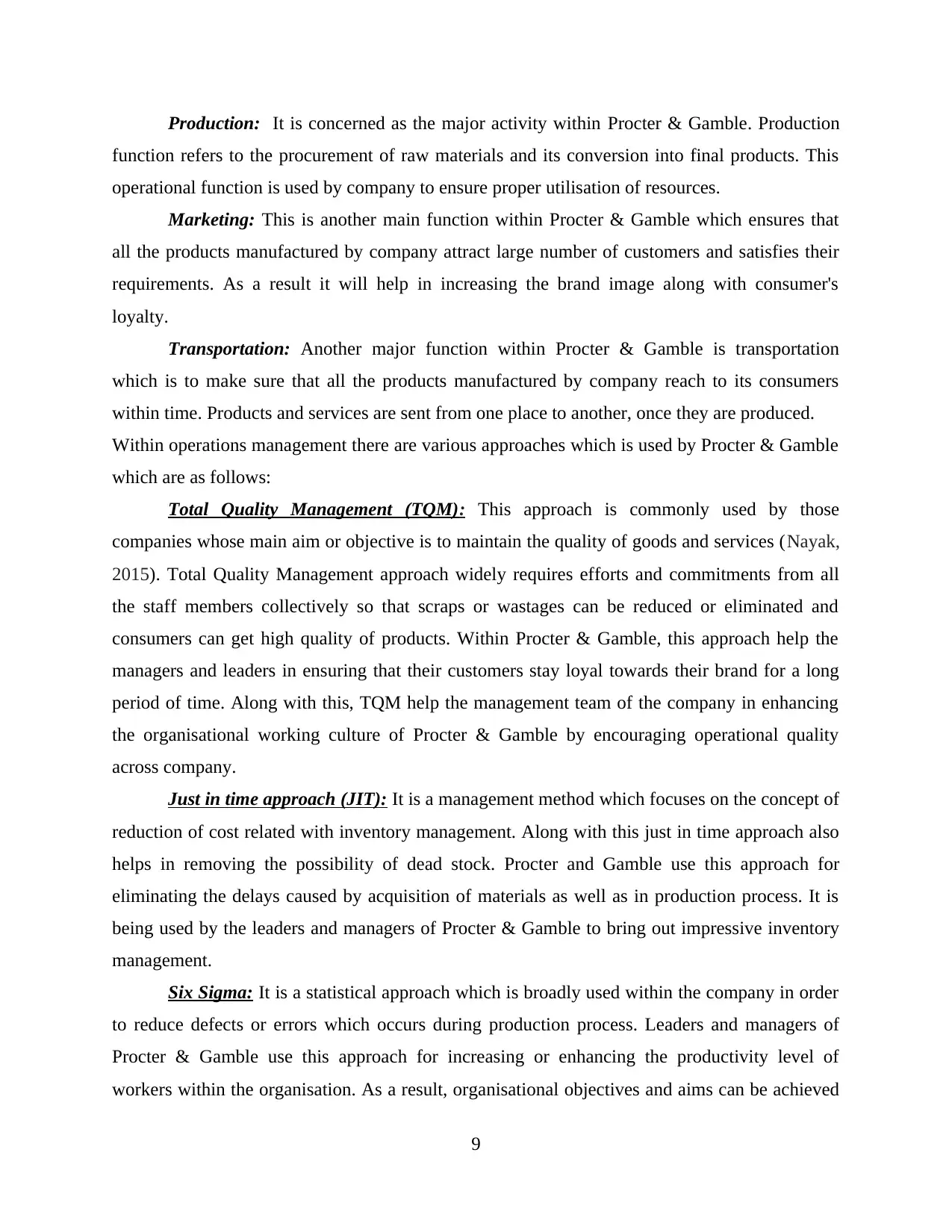
Production: It is concerned as the major activity within Procter & Gamble. Production
function refers to the procurement of raw materials and its conversion into final products. This
operational function is used by company to ensure proper utilisation of resources.
Marketing: This is another main function within Procter & Gamble which ensures that
all the products manufactured by company attract large number of customers and satisfies their
requirements. As a result it will help in increasing the brand image along with consumer's
loyalty.
Transportation: Another major function within Procter & Gamble is transportation
which is to make sure that all the products manufactured by company reach to its consumers
within time. Products and services are sent from one place to another, once they are produced.
Within operations management there are various approaches which is used by Procter & Gamble
which are as follows:
Total Quality Management (TQM): This approach is commonly used by those
companies whose main aim or objective is to maintain the quality of goods and services (Nayak,
2015). Total Quality Management approach widely requires efforts and commitments from all
the staff members collectively so that scraps or wastages can be reduced or eliminated and
consumers can get high quality of products. Within Procter & Gamble, this approach help the
managers and leaders in ensuring that their customers stay loyal towards their brand for a long
period of time. Along with this, TQM help the management team of the company in enhancing
the organisational working culture of Procter & Gamble by encouraging operational quality
across company.
Just in time approach (JIT): It is a management method which focuses on the concept of
reduction of cost related with inventory management. Along with this just in time approach also
helps in removing the possibility of dead stock. Procter and Gamble use this approach for
eliminating the delays caused by acquisition of materials as well as in production process. It is
being used by the leaders and managers of Procter & Gamble to bring out impressive inventory
management.
Six Sigma: It is a statistical approach which is broadly used within the company in order
to reduce defects or errors which occurs during production process. Leaders and managers of
Procter & Gamble use this approach for increasing or enhancing the productivity level of
workers within the organisation. As a result, organisational objectives and aims can be achieved
9
function refers to the procurement of raw materials and its conversion into final products. This
operational function is used by company to ensure proper utilisation of resources.
Marketing: This is another main function within Procter & Gamble which ensures that
all the products manufactured by company attract large number of customers and satisfies their
requirements. As a result it will help in increasing the brand image along with consumer's
loyalty.
Transportation: Another major function within Procter & Gamble is transportation
which is to make sure that all the products manufactured by company reach to its consumers
within time. Products and services are sent from one place to another, once they are produced.
Within operations management there are various approaches which is used by Procter & Gamble
which are as follows:
Total Quality Management (TQM): This approach is commonly used by those
companies whose main aim or objective is to maintain the quality of goods and services (Nayak,
2015). Total Quality Management approach widely requires efforts and commitments from all
the staff members collectively so that scraps or wastages can be reduced or eliminated and
consumers can get high quality of products. Within Procter & Gamble, this approach help the
managers and leaders in ensuring that their customers stay loyal towards their brand for a long
period of time. Along with this, TQM help the management team of the company in enhancing
the organisational working culture of Procter & Gamble by encouraging operational quality
across company.
Just in time approach (JIT): It is a management method which focuses on the concept of
reduction of cost related with inventory management. Along with this just in time approach also
helps in removing the possibility of dead stock. Procter and Gamble use this approach for
eliminating the delays caused by acquisition of materials as well as in production process. It is
being used by the leaders and managers of Procter & Gamble to bring out impressive inventory
management.
Six Sigma: It is a statistical approach which is broadly used within the company in order
to reduce defects or errors which occurs during production process. Leaders and managers of
Procter & Gamble use this approach for increasing or enhancing the productivity level of
workers within the organisation. As a result, organisational objectives and aims can be achieved
9
⊘ This is a preview!⊘
Do you want full access?
Subscribe today to unlock all pages.

Trusted by 1+ million students worldwide
1 out of 17
Related Documents
Your All-in-One AI-Powered Toolkit for Academic Success.
+13062052269
info@desklib.com
Available 24*7 on WhatsApp / Email
![[object Object]](/_next/static/media/star-bottom.7253800d.svg)
Unlock your academic potential
Copyright © 2020–2025 A2Z Services. All Rights Reserved. Developed and managed by ZUCOL.




